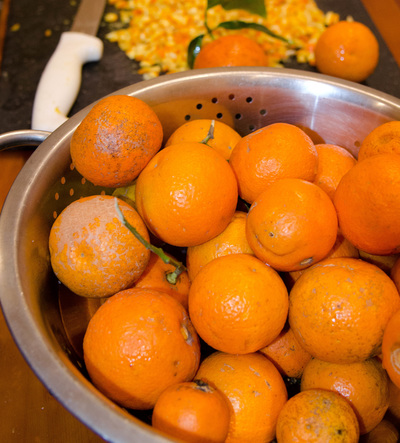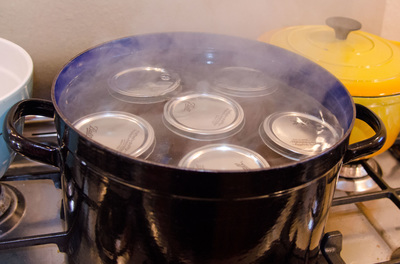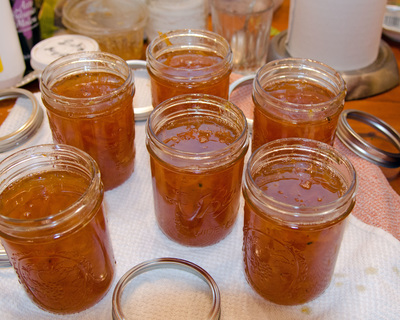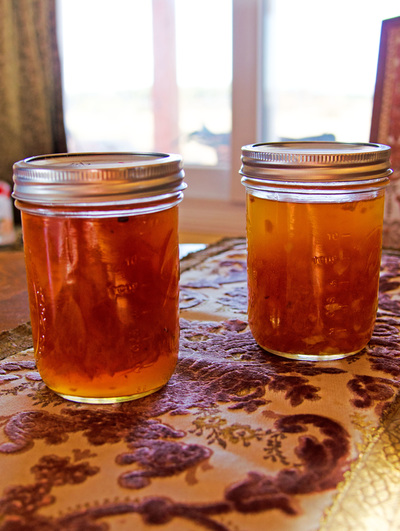Read about more about my adventures while MAKING ORANGE MARMALADE in my blog: Big Coffee Cup!
1 kilo Seville oranges (about 2 1/4 pounds) You can use any kind of oranges. Sevilles are bitter. You may want to use a bit less sugar with regular oranges.
juice of 2 lemons
2 kilos (10 cups) sugar
1/2 to 1 teaspoon ground clove (optional)
6 or 7 Mason or Ball canning jars with lids and rings
tongs
juice of 2 lemons
2 kilos (10 cups) sugar
1/2 to 1 teaspoon ground clove (optional)
6 or 7 Mason or Ball canning jars with lids and rings
tongs
- Wash oranges and gently cut out "buttons" at the top of the orange (part where the stem would be).
- Cut all oranges in half and squeeze out juice, reserving any seeds and membranes accumulate in juicer. Set seed mixture aside in a bowl.
- Spoon out remaining seeds and membrane; add to bowl of seed mixture.
- Cut orange peels in half again - the quartered size is easy to work with. With a sharp knife, cut away most of the white part (the pith) and add it to the seed mixture bowl. You will need all of the pith, membrane, and seeds, because they contribute the natural pectin to your marmalade, causing it to gel.
- After removing pith, slice orange peels into very fine slices. I sliced mine around and inch and 1/2 long and 1/8 wide.
- Using cheesecloth or muslin, tie-up the seed, pith, and membrane into a bag.
- Place the orange juice, sliced peel, and bag into a large bowl. Add 2 liters of water. Cover with a clean dishtowel and let soak overnight up to 24 hours. This step is necessary to soften the peel and release the pectin.
- Pour the whole mixture into a large cooking pot. I added ground clove at this point as an experiment. It was fabulous. Clove can be a strong spice, so don't use too much. Cover and bring to a boil, then simmer for about 2 hours, covered for one and 1/2 hours and uncovered for 1/2 hour.
- Remove the bag, squeezing it against the side of the pot to release the pectin gel.
- Add lemon juice and sugar to the pot.
- Put 2 or 3 small saucers in the refrigerator or freezer for testing your marmalade set point.
- Bring all to a boil, stirring until sugar is dissolved. Then boil rapidly until you reach the setting point - the point where the marmalade begins to "gel." This takes from 20 minutes to 40 minutes, Test after 20 minutes by taking a saucer from the fridge and dropping a spoonful of the marmalade onto the saucer. Set aside for about a minute, then tilt the saucer. If the mixture flows freely, it is NOT ready. It should move slowly, like honey or syrup. Keep boiling and test again every 5 minutes or so. It took me 40 minutes. Be careful not to overcook, as the orange peels will get hard and the marmalade will be too "stiff."
- While the marmalade is cooking, boil about 6 or 7 Mason jars, the screw tops (not the flat lids), tongs, and ladle in rapidly boiling water for 10 minutes to sterilize. DON'T let jars touch the bottom of the pot - use racks to elevate them. After you turn off the heat, throw in the flat lids.
- When marmalade finished, remove from the heat and let cool for about 10 minutes. If you put the marmalade into canning jars when it is too hot, all the peels will float to the top!
- Pour marmalade within 1/2 inch or 3mm from the screw top of sterilized jars. Wipe the outer rim with a wet paper towel, then seal immediately. Don't over-tighten the jar rings.
- Put filled jars back into the hot water bath, return to boiling, and boil for 10 minutes. Be careful not to let the jars touch each other. Remove carefully with tongs and set to cool.






